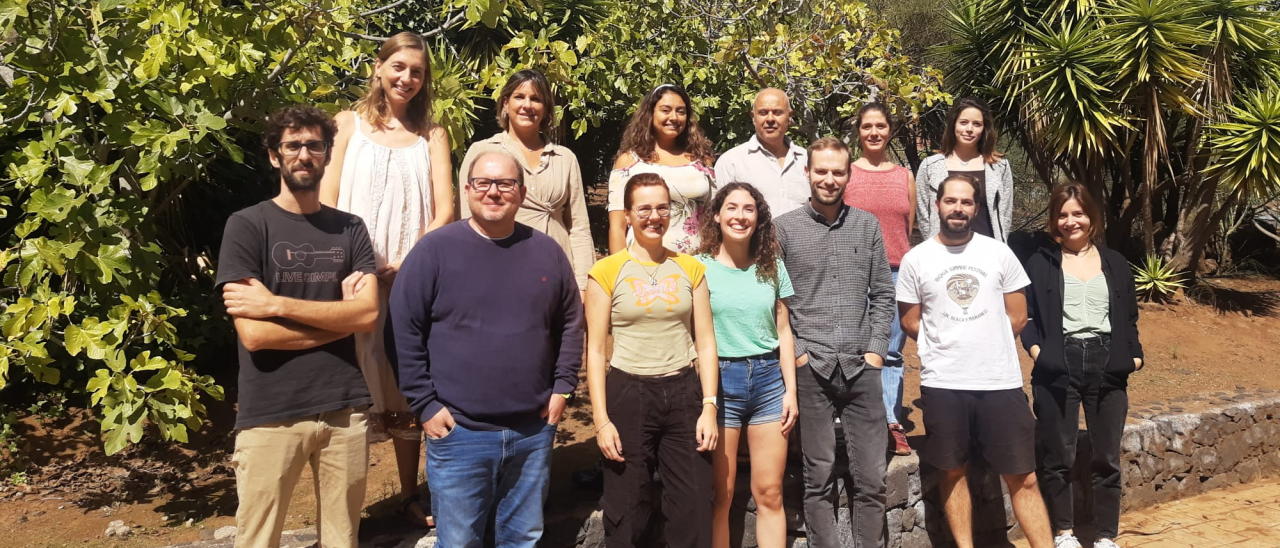Grants related:
General
Welcome to the Traces of Galaxy Formation research group website.
We are a large, diverse, and very active research group aiming to provide a comprehensive picture for the formation of galaxies in the Universe. Rooted in detailed stellar population analysis, we are constantly exploring and developing new tools and ideas to understand how galaxies came to be what we now observe.
A complex star formation history, as the one expected to describe galaxy evolution, needs a multidisciplinary approach to be fully understood. Our group at the IAC consists of experienced researchers in cosmological simulations, dynamical studies, stellar populations and morphological properties of galaxies up to high redshift. We combine different approaches (e.g. observations and theory, secular and cosmological evolution studies) to obtain a complete view of the dominant mechanisms driving the evolution of galaxies.
Within this general framework, we are currently exploring three main areas of research:
- Stellar population synthesis models
- Development of new stellar population synthesis models
- Stellar population analysis tools
- Universality of the stellar initial mass function (IMF)
- Cosmic evolution of galaxies
- Massive galaxy evolution
- Stellar populations in different environments
- Low surface brightness science
- Machine learning and cosmological simulations
- Evolutionary processes in nearby galaxies
- The role of black holes in the evolution of galaxies
- Surveys of nearby galaxies
- Stellar kinematics and dynamical models
If you want to get in contact or work with us, please send an email to the head of the group (Ignacio Martín-Navarro ignacio.martin [at] iac.es (ignacio[dot]martin[at]iac[dot]es)).
Members
Results
Here you can find some of our most recent highlights:
- Local variations of the stellar velocity ellipsoid - II. The effect of the bar in the inner regions of Auriga galaxies. Walo et al. 2022, MNRAS (https://ui.adsabs.harvard.edu/abs/2022MNRAS.513.4587W)
- Anisotropic satellite galaxy quenching modulated by black hole activity. Martín-Navarro et al. 2021, Nature (https://ui.adsabs.harvard.edu/abs/2021Natur.594..187M)
- Evaluating hydrodynamical simulations with green valley galaxies. Angthopo et al. 2021, MNRAS (https://ui.adsabs.harvard.edu/abs/2021MNRAS.502.3685A)
- Sub one per cent mass fractions of young stars in red massive galaxies. Salvador-Rusiñol et al. 2020, Nature Astronomy (https://ui.adsabs.harvard.edu/abs/2020NatAs...4..252S)
- Detection of young stellar populations in apparently quenched low-mass galaxies using red spectral line indices. de Lorenzo-Cáceres et al. 2020, MNRAS (https://ui.adsabs.harvard.edu/abs/2020MNRAS.498.1002D)
Scientific activity
Related publications
-
The survival of stellar discs in Fornax-like environments, from TNG50 to real galaxies
We study the evolution of kinematically defined stellar discs in 10 Fornax-like clusters identified in the TNG50 run from the IllustrisTNG suite of cosmological simulations. We considered disc galaxies with present-day stellar mass M ⋆ ≥ 3 × 10 8 M ⊙ and follow their evolution since first entering their host cluster. Very few stellar discs survive
Galán-de Anta, Pablo M. et al.Advertised on:
122022 -
EMIR, the near-infrared camera and multi-object spectrograph for the GTC. EMIR at GTC
We present EMIR, a powerful near-infrared (NIR) camera and multi-object spectrograph (MOS) installed at the Nasmyth focus of the 10.4 m GTC. EMIR was commissioned in mid-2016 and is offered as a common-user instrument. It provides spectral coverage of 0.9-2.5 µm over a field of view (FOV) of 6.67' × 6.67' in imaging mode, and 6.67' × 4' in
Garzón, F. et al.Advertised on:
112022 -
The SAMI-Fornax Dwarfs Survey - II. The Stellar Mass Fundamental Plane and the dark matter fraction of dwarf galaxies
We explore the kinematic scaling relations of 38 dwarf galaxies in the Fornax Cluster using observations from the SAMI integral field spectrograph. We focus on the Fundamental Plane (FP), defined by the physical properties of the objects (scale length, surface brightness, and velocity dispersion) and the Stellar Mass (Fundamental) Plane, where
Eftekhari, F. Sara et al.Advertised on:
122022 -
The edges of galaxies: Tracing the limits of star formation
The outskirts of galaxies have been studied from multiple perspectives for the past few decades. However, it is still unknown if all galaxies have clear-cut edges similar to everyday objects. We address this question by developing physically motivated criteria to define the edges of galaxies. Based on the gas density threshold required for star
Chamba, Nushkia et al.Advertised on:
112022 -
Non-Gaussianity of optical emission lines in SDSS star-forming galaxies and its implications on galactic outflows
The shape of emission lines in the optical spectra of star-forming galaxies reveals the kinematics of the diffuse gaseous component. We analyse the shape of prominent emission lines in a sample of $∼$ 53000 star-forming galaxies from the Sloan Digital Sky Survey, focusing on departures from gaussianity. Departures from a single gaussian profile
Yu, B. P. Brian et al.Advertised on:
112022 -
The stellar populations of quiescent ultra-diffuse galaxies from optical to mid-infrared spectral energy distribution fitting
We use spectral energy distribution (SED) fitting to place constraints on the stellar population properties of 29 quiescent ultra-diffuse galaxies (UDGs) across different environments. We use the fully Bayesian routine PROSPECTOR coupled with archival data in the optical, near, and mid-infrared from Spitzer and Wide-field Infrared Survey Explorer
Buzzo, Maria Luisa et al.Advertised on:
122022 -
On the accretion of a new group of galaxies on to Virgo - II. The effect of pre-processing on the stellar population content of dEs
Using MUSE spectra, we investigate how pre-processing and accretion on to a galaxy cluster affect the integrated stellar population properties of dwarf early-type galaxies (dEs). We analyse a sample of nine dEs with stellar masses of $\rm \sim 10^9 \, M_\odot$, which were accreted (~ 2-3 Gyr ago) on to the Virgo cluster as members of a massive
Bidaran, Bahar et al.Advertised on:
92022 -
Non-solar abundance ratios trends of dEs in the Fornax Cluster using newly defined high-resolution indices
We perform a detailed study of the stellar populations in a sample of massive Fornax dwarf galaxies using a set of newly defined line indices. Using data from the Integral Field Spectroscopic data, we study abundance ratios of eight dEs with stellar mass ranging from 10 8 to 10 9.5 M ⊙ in the Fornax Cluster. We present the definitions of a new set
Şen, Şeyda et al.Advertised on:
92022 -
The Fornax3D project: Discovery of ancient massive merger events in the Fornax cluster galaxies NGC 1380 and NGC 1427
We report the discovery of ancient massive merger events in the early-type galaxies NGC 1380 and NGC 1427, members of the Fornax galaxy cluster. Both galaxies have been observed by the MUSE integral-field-unit instrument on the VLT as part of the Fornax3D project. By fitting recently developed population-orbital superposition models to the observed
Zhu, Ling et al.Advertised on:
82022 -
Lessons from the massive relic NGC 1277: Remaining in situstar formation in the cores of massive galaxies
Near-ultraviolet (NUV) spectroscopic studies have suggested that passively evolving massive, early-type galaxies host sub-one per cent fractions of young stars in their innermost regions. We shed light on the origin of these stars by analysing NGC 1277, a widely studied nearby prototypical massive compact relic galaxy. These are rare galaxies that
Salvador-Rusiñol, N. et al.Advertised on:
92022 -
Fornax3D project: Assembly history of massive early-type galaxies in the Fornax cluster from deep imaging and integral field spectroscopy
This work is based on high-quality integral-field spectroscopic data obtained with the Multi Unit Spectroscopic Explorer (MUSE) on the Very Large Telescope (VLT). The 21 brightest (m B ≤ 15 mag) early-type galaxies (ETGs) inside the virial radius of the Fornax cluster are observed out to distances of ∼2−3 R e. Deep imaging from the VLT Survey
Spavone, M. et al.Advertised on:
72022 -
The relic galaxy NGC 1277 rules out intermediate-age stellar populations origin of CO-strong absorptions in massive early-type galaxies
Massive early-type galaxies (ETGs) show several strong CO absorption features in their H- and K-band spectra that cannot be explained by state-of-the-art stellar population models. For many years, the disagreement has been attributed to the presence of intermediate-age stellar components that are dominated by stars in the asymptotic giant branch
Eftekhari, Elham et al.Advertised on:
92022 -
Testing the role of AGN on the star formation and metal enrichment of 'twin galaxies'
We explore the effect of AGN activity on the star formation history of galaxies by analysing the stellar population properties of 10 pairs of nearby twin galaxies - selected as being visually similar except for the presence of an AGN. The selection of such twin samples represents a method to study AGN feedback, as recently proposed by del Moral
Angthopo, J. et al.Advertised on:
92022 -
The black hole population in low-mass galaxies in large-scale cosmological simulations
Recent systematic searches for massive black holes (BHs) in local dwarf galaxies led to the discovery of a population of faint active galactic nuclei (AGNs). We investigate the agreement of the BH and AGN populations in the Illustris, TNG, Horizon-AGN, EAGLE, and SIMBA simulations with current observational constraints in low-mass galaxies. We find
Haidar, Houda et al.Advertised on:
82022 -
The Fornax3D project: intrinsic correlations between orbital properties and the stellar initial mass function
Variations of the stellar initial mass function (IMF) in external galaxies have been inferred from a variety of independent probes. Yet the physical conditions causing these variations remain largely unknown. In this work, we explore new spatially resolved measurements of the IMF for three edge-on lenticular galaxies in the Fornax cluster. We
Poci, A. et al.Advertised on:
82022 -
Local variations of the stellar velocity ellipsoid - II. The effect of the bar in the inner regions of Auriga galaxies
Theoretical works have shown that off-plane motions of bars can heat stars in the vertical direction during buckling but is not clear how do they affect the rest of components of the stellar velocity ellipsoid (SVE). We study the 2D spatial distribution of the vertical, σ z, azimuthal, σ ϕ, and radial, σ r velocity dispersions in the inner regions
Walo-Martín, Daniel et al.Advertised on:
72022 -
Modelling simple stellar populations in the near-ultraviolet to near-infrared with the X-shooter Spectral Library (XSL)
We present simple stellar population models based on the empirical X-shooter Spectral Library (XSL) from near-ultraviolet (NUV) to near-infrared (NIR) wavelengths. The unmatched characteristics of the relatively high resolution and extended wavelength coverage (350-2480 nm, R ∼ 10 000) of the XSL population models bring us closer to bridging
Verro, K. et al.Advertised on:
52022 -
The Fornax3D project: The environmental impact on gas metallicity gradients in Fornax cluster galaxies
The role played by environment in galaxy evolution is a topic of ongoing debate among astronomers. There has been little success in elucidating the degree to which environment can alter, re-shape, or drive galaxy evolution, that is, using either observations or simulations. However, our knowledge of the effect of environment on gas metallicity
Lara-López, M. A. et al.Advertised on:
42022 -
From Naked Spheroids to Disky Galaxies: How Do Massive Disk Galaxies Shape Their Morphology?
We investigate the assembly history of massive disk galaxies and describe how they shape their morphology through cosmic time. Using SHARDS and HST data, we modeled the surface brightness distribution of 91 massive galaxies at redshift 0.14 < z ≤ 1 in the wavelength range 0.5-1.6 μm, deriving the uncontaminated spectral energy distributions of
Costantin, Luca et al.Advertised on:
42022 -
The X-shooter Spectral Library (XSL): Data Release 3
We present the third data release (DR3) of the X-shooter Spectral Library (XSL). This moderate-to-high resolution, near-ultraviolet-to-near-infrared (350-2480 nm, R ∼ 10 000) spectral library is composed of 830 stellar spectra of 683 stars. DR3 improves upon the previous data release by providing the combined de-reddened spectra of the three X
Verro, K. et al.Advertised on:
42022



